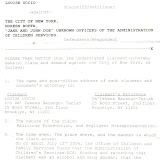For more information contact:
Edward Borges, 518-473-7793,
edward.borges@ocfs.state.ny.us
NY Office of Children & Family Services Accelerating Transformation of Juvenile Justice System
Agency Closing, Reducing, or Merging Underutilized Residential Facilities to Improve Services to Children & Help Prevent Youth Crime
Agency Closing, Reducing, or Merging Underutilized Residential Facilities to Improve Services to Children & Help Prevent Youth Crime
RENSSELAER, NY (01/11/2008; 1314)
New York State Office of Children & Family Services Commissioner Gladys Carrión today announced the closing of six underutilized residential facilities as part of an ongoing restructuring to significantly improve services to troubled children.
The agency is closing the Adirondack Wilderness Challenge in Clinton County, Auburn Residential Center in Cayuga County, Brace Residential Center in Delaware County, Gloversville Group Home in Fulton County, Great Valley Residential Center in Cattaraugus County, and the Pyramid Reception Center in The Bronx.
OCFS also is reducing by half the number of beds at the Lansing Residential Center in Tompkins County. The program at the Adirondack Wilderness will be merged into the Adirondack Residential Center, and the intake functions at Pyramid will be relocated to the Ella McQueen Residential Center in Brooklyn.
These changes take effect on Jan. 11, 2009, consistent with a state law that requires a 12-month notification process prior to the closure of residential facilities in the OCFS system.
There are approximately 2,000 children in New York State’s juvenile justice system, and most of them are between 12 and 18 years old. A few are as young as 10. They were all under the age of 16 when they committed an act that would have been a crime if committed by an adult.
These closings, reductions, and mergers are at non-secure and limited-secure facilities housing children adjudicated as juvenile delinquents by the family courts. The vast majority of the children in these facilities were placed in the system for committing misdemeanors. No youth will be released prematurely as a result of the restructuring.
Secure facilities housing juvenile offenders, those children sentenced for committing felonies, will not be directly impacted by these facility changes.
This ongoing restructuring is driven by a widely shared recognition among children’s advocates and legal experts that the needs of New York’s children, families, and communities are not adequately addressed by the juvenile justice system. Since 2002, OCFS has reduced 379 beds in its residential facilities. With these closings, the total reduction of beds rises to 620.
Many of the children in these facilities have mental health issues, learning disabilities, and substance and alcohol abuse problems and come from some of the poorest communities in the state. Additionally, it has been estimated that 80 percent of these children who enter the juvenile justice system return or go to prison within three years of their release.
“What these children need is intervention and support,” said Commissioner Carrión. “This includes an education, job training, and mental health and substance abuse services to support their rehabilitation and return to the community. It is our responsibility to prepare them for a successful transition to adulthood.”
In addition to the system’s failure to address these children’s needs, it is also wasteful. Nearly a dozen of the state’s youth facilities are operating under 40 percent of capacity. At some facilities, a quarter of the beds are filled.
“Instead of continuing to pour money into this broken system and confining these children to facilities hundreds of miles from their homes, OCFS has aggressively been moving toward more community-based alternatives to incarceration where these children can maintain and strengthen connections with their families and the significant adults in their lives,” the Commissioner said.
Community-based programs, such as those in Missouri, have proven to better prevent youth crime and to drop recidivism rates to as low as 30 percent – at a fraction of the cost New York State is currently paying to maintain empty beds.
This new paradigm includes placing an emphasis on working with families from the first day a child enters the state juvenile justice system. Just last year, the agency enhanced staffing by 218 new positions, including 36 mental health professionals, to better meet these children’s needs.
These closings, reductions, and mergers will result in $16 million in annual savings.
The OCFS Office of Human Resources, the state Department of Civil Service, and the state Department of Labor have organized teams to assist the employees at these impacted facilities to identify and secure positions at other facilities or other state agencies.
Department of Civil Service Commissioner Nancy G. Groenwegen said, "Our goal at Civil Service is to find an alternative State employment opportunity for every one of the affected workers. We have experience at this and will work closely with OCFS, other State agencies, and employees themselves to make this transition as smooth as possible."
The Office of Children and Family Services’ mission is to promote the well-being, safety, and permanency of New York’s children and families by setting and enforcing policies, building partnerships, and funding and providing high-quality services. The agency is responsible for foster care; adoption; adoption assistance; child protective services, including operating the Statewide Central Register of Child Abuse and Maltreatment; preventive services for children and families; services for pregnant adolescents; child care licensing and funding; and operating the state juvenile justice programs. The agency also is responsible for protective programs for vulnerable adults, including adult protective services and the Commission for the Blind and Visually Handicapped.
###
NEW YORK STATE OFFICE OF CHILDREN & FAMILY SERVICES
FACT SHEET ON CLOSINGS, REDUCTIONS & MERGERS OF UNDERUTILIZED RESIDENTIAL FACILITIES
NEW YORK STATE OFFICE OF CHILDREN & FAMILY SERVICES
FACT SHEET ON CLOSINGS, REDUCTIONS & MERGERS OF UNDERUTILIZED RESIDENTIAL FACILITIES
The Problem
New York State’s juvenile justice system needs to be fixed.
The system is predominantly populated by troubled children – mostly African-American and Latino - from the poorest communities in the state. Many of them have mental health issues, learning disabilities, or substance and alcohol abuse problems.
The system was designed around the idea that if the state took these children away from their families and the neighborhoods where they got into difficulty they could be rehabilitated.
It hasn’t worked that way for a long time. Instead, it’s been estimated, 80 percent of the children who enter New York State’s juvenile justice system return or go to prison within three years of their release. The needs of these children, their families, and their communities are clearly not adequately addressed by the current model.
The system is also inefficient. Nearly a dozen of the state’s youth facilities are operating under 40 percent of capacity. At some facilities, only a quarter of the beds are filled. Just this past Monday (Jan. 7), 86 percent of the beds in the non-secure facilities that are closing and 33 percent of the beds in limited secure facilities that are closing were empty. An analysis of historic trends and projections of future usage indicate these beds will not be filled in the near future. This is partially due to local municipalities stepping up and creating community-based programs as alternatives to incarceration to keep these children closer to home.
The Children
There are 2,000 children in New York State’s juvenile justice system. They were all under the age of 16 when they were confined. Most of them are between 12 and 18-years-old. A few are as young as ten.
Eighty-six (86) percent of the youth in state custody are African-American or Latino. Ninety-five (95) percent of the youth in state custody who are from New York City are African-American or Latino.
Most of these children have mental health problems, learning disabilities, or substance and alcohol addictions.
The vast majority of children in non-secure and limited secure residential facilities were judged by the family courts to be juvenile delinquents for committing misdemeanors.
No child currently in the impacted facilities is a resident of the county in which the facility is located. Over 70 percent of them are from New York City.
The Solution
Based on these facts, OCFS has determined that closing some facilities and placing these children in community-based alternative-to-incarceration programs closer to their homes and families will help them successfully return to their neighborhoods and result in lower recidivism rates.
Closings, Reductions, Mergers, Relocations
Based on underutilization, OCFS has decided to close the following non-secure or limited-secure facilities:
Auburn Residential Center in Auburn in Cayuga County
Adirondack Wilderness Program in Schuyler Falls in Clinton County
Brace Residential Center in Masonville in Delaware County
Gloversville Group Home in Gloversville in Fulton County
Great Valley Residential Center in Great Valley in Cattaraugus County
Pyramid Reception Center in The Bronx
The agency also is reducing by half the number of beds at:
Lansing Residential Center in Lansing in Tompkins County
There are presently 35 residential facilities in the system. With these closings there will be 28.
Effect
Effect
These changes take effect 12 months from today’s announcement, per state law.
Savings
Savings
These closings, reductions, and mergers will result in $16 million in annual savings, making
possible investments in community-based programs and services for vulnerable youth.
Reductions
Since 2002, OCFS has reduced 379 beds in its residential facilities. With these closings, the total reduction of beds rises to 620.
The Parents
OCFS staff will be calling all the parents of the remaining children in these underutilized facilities to inform them of the closings and following up by mail.
Facility Details
Adirondack Residential is a non-secure and limited secure residential facility for boys. It has 24 beds. Adirondack Wilderness Challenge is a four-month residential and outdoor experiential education program for boys 13 to 17-years-old, which includes hiking and overnight camping trips. These programs have 25 full-time positions. This property belongs to the state Department of Environmental Conservation.
Auburn Residential Center is a non-secure facility for girls aged 13 to 17-years-old. It has 24 beds, but only three children. It has 25 full-time positions.
Brace is a limited secure facility for juvenile delinquents aged 12 to 17-years-old. It has 25 beds, but only six children. It has 25 full-time positions. This property belongs to the state Department of Environmental Conservation.
Cass Residential Center is currently used as a training facility. It has 25 full-time positions. It will be transferred to the state Department of Parks & Recreation, which will continue to use it as a training center for its own employees.
Gloversville Group Home has not been in use for over a year. It has seven full-time positions. Its lease, which runs out on June 2008, will be terminated.
Great Valley is a non-secure to limited secure facility for male juvenile delinquents 13 to 18-years-old. It has 25 beds, but only nine children. Great Valley has 25 full-time positions. This property belongs to the state Department of Environmental Conservation.
Lansing is a limited secure facility for female juvenile delinquents aged 12 to 18-years-old. It has 100 beds, but only 48 children. Its capacity will be reduced to 50 beds. Lansing has 32 full-time positions.
Pyramid is a 57-bed reception center on East 161st Street in The Bronx where male juvenile delinquents undertake psychological, educational, vocational, and intake assessment tests over a 14-day orientation to determine their most appropriate placement. It has 90 full-time positions. These reception and assessment functions will be transferred to the Ella McQueen Residential Center on Howard Avenue in Brooklyn.
Criteria
A number of different criteria were considered in decided which facilities to close. These include the condition of the physical plant and the cost involved in upgrading it. This was an important factor in the decision made around moving the intake function out of Pyramid and relocating it to Ella McQueen. Other criteria used were the location of the programs and their geographic proximity to other programs, as was the case with Lansing and Auburn and the Adirondack Wilderness Challenge and Group Home. The proximity of these programs to each other gave OCFS more options for staff reassignment. We also considered the demographic trends of the youth in the facilities and the distance from New York City.
Legal Process
OCFS closings, service and staff reductions, and transfer of any operations must comply with state law. This includes formal announcements to employee labor organizations, individual staffers, local governments where the changes occur, community organizations, and consumer and advocacy groups at least twelve months before changes are scheduled to occur.
The law also requires that the agency coordinate with the state Department of Civil Service, the Office of Employee Relations, and any other state agency to develop strategies to minimize the impact on the state workforce, in cooperation with representatives of employee labor organizations and managerial and confidential employees.
In addition, OCFS must consult with the Department of Economic Development and other appropriate state agencies to minimize the impact on local and regional economies.
Disposition of Property
Per state law, OCFS will be consulting with the Office of General Services on the disposition of these individual properties.
Staff
OCFS will be doing everything possible to minimize the impact these facility closures will have on employees and their families. After all, OCFS’s principal mission is to support all children and families, including our own employees.
Building on the agency’s successful management of the closure of Harlem Valley Secure Center several years ago, OCFS is working closely with the state Departments of Civil Service and Labor to assist the staff at these impacted facilities to identify and secure positions at other facilities or other state agencies.
Agency Mission
The Office of Children and Family Services mission is to promote the well-being, safety, and permanency of New York’s children and families by setting and enforcing policies, building partnerships, and funding and providing high-quality services. The agency is responsible for foster care; adoption; adoption assistance; child protective services, including operating the Statewide Central Register of Child Abuse and Maltreatment; preventive services for children and families; services for pregnant adolescents; child care licensing and funding; and operating the state juvenile justice programs. The agency also is responsible for protective programs for vulnerable adults, including adult protective services and the Commission for the Blind and Visually Handicapped.
Commissioner
New York State Governor Eliot Spitzer named Gladys Carrión, Esq. commissioner of the New York State Office of Children and Family Services in January, 2007. Ms. Carrión previously served as Senior Vice President for Community Investment at United Way of New York City. Prior to that, she was Executive Director of Inwood House from 1999 to 2005. From 1995 to 1999, Ms. Carrión served as Executive Director of Family Dynamics, Inc and in 1994 she was a Program Officer at the Ford Foundation in the Community Development area. Ms. Carrión served as Commissioner of the New York City Community Development Agency from 1990 to 1993. From 1984 to 1988, she worked at the New York State Workers' Compensation Board in a variety of capacities including General Counsel, Supervising Law Judge and Senior Law Judge. Ms. Carrión also served as Acting Executive Director of ASPIRA from 1982 to 1983. She received her B.S. from Fordham University in 1973 and her J.D. from the New York University School of Law in 1976.
Contact Information
Edward Borges
Director of Communications
NYS Office of Children and Family Services
518.473.7793
edward.borges@ocfs.state.ny.us
52 Washington Street, Suite 305 South
Rensselaer, NY
Edward Borges
Director of Communications
NYS Office of Children and Family Services
518.473.7793
edward.borges@ocfs.state.ny.us
52 Washington Street, Suite 305 South
Rensselaer, NY
Original Article -























No comments:
Post a Comment